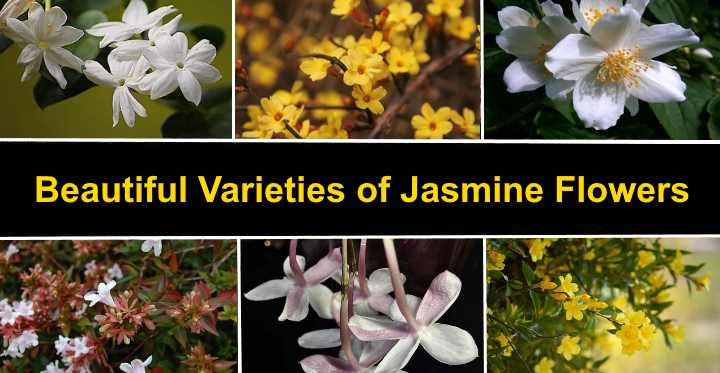The clean white color and exquisite fragrance of jasmine blooms have made them famous. The Jasmine genus belongs to the Oleaceae family and includes fragrant shrubs and vines. Jasmine, olive, lilac, and forsythia plants are all in the same subgroup.
Jasmine shrubs and vines come in about 200 different varieties. They are native to Asia and Oceania, but have now been grown in a variety of other regions of the globe. The majority of them grow in tropical and warmer climates. Jasmine blooms are tiny fragrant white or yellow blooms that bloom in clusters. From spring to fall, the jasmine plant blooms. The plant is a lovely addition to any garden or even as a houseplant that grows in an indoor container, with its dark green leaves contrasting with pure white or yellow blooms.
Jasmine plants thrive in both full and partial sun. The soil should be moist and well-drained at all times. Some pruning is required if you want to keep jasmine as a shrub. Yet, little upkeep is necessary if you want to festoon arbors, trellises, or pergolas. To encourage robust and healthy development of your indoor jasmine plant, you’ll want to place it in a partly sunny location. You’ll need a trellis to support the growth of the jasmine plant as well as trim it periodically to regulate its spread when it grows taller indoors.
Deciduous jasmine, such as winter jasmine, and evergreen jasmine, like Arabian jasmine, are both possible. Winter jasmine is the most cold hardy of all jasmine species and is more cold hardy than others. Tender jasmines, such as Angel Wing Jasmine, thrive in temperatures of more than 40°F (4.5°C).
One of the most fragrant of the jasmine species is common jasmine, which is also the most popular. Royal Jasmine, Arabian Jasmine, Italian Jasmine, and even Pink Jasmine are some of the other types of jasmine fragrant bush. You’ll learn how to recognize characteristics of numerous jasmine species in this article.
Types of Jasmine Flowers (With Pictures and Names)
Let’s look at some of the distinguishing features of jasmine shrubs and vines in further detail. Pictures of jasmine flowers and the scientific names of each variety are included in the following list of jasmine plants.
Common Jasmine (Jasminum officinale)

Common jasmine is the most fragrant of the jasmine varieties, with its tiny blossoms. It’s a semi-evergreen or deciduous climbing vine that grows quickly. It has heavenly white blooms that emit a intoxicating fragrance. Summer jasmine, white jasmine, and poet’s jasmine are some of the other names for common jasmine.
Common jasmine usually blooms from late spring until early autumn. The plant produces clusters of 5-petalled flowers that bloom together. These clusters of aromatic white blooms are approximately 1″ (2.5 cm) wide. Common jasmine has green fuzzy leaves that grow in a feathery pattern on its stems (pinnate). The tips of these leaves are rounded.
Common jasmine is suited for covering trellises, arbors, or walls because of its vigorous climbing habits. Jasmine may also be grown in containers or utilized as a low-growing ground cover. This jasmine variety may reach a height of 15 to 30 feet (4.5 to 9 meters) and a width of up to 15 feet (4.5 meters). Zones 7 through 10 are ideal for it.
Angel Wing Jasmine (Jasminum nitidum)

Angel Wing jasmine (Jasminum nitidum) has lovely flowers with long, slender petals that resemble white stars. Angel Wing jasmine is a climbing vine with fragrant white flowers that is similar to common jasmine. ‘Star jasmine,’ ‘Shining jasmine,’ and ‘Pinwheel jasmine are some of the other names for this jasmine plant. All of these names refer to a distinguishing characteristic.
Angel Wing jasmine has long, slender petals that spread out to resemble white rays, and its huge ivory-white blooms. These tiny flowers have a jasmine-like fragrance and may grow to be about 2” (5 cm) across. Angel Wing jasmine blossoms develop in clusters and bloom from late spring to the end of summer, much as many other jasmine shrubs do. This is a particularly attractive plant because of the purple undersides of the flowers. The glossy green leaves are one of the jasmine species’ distinguishing characteristics.
Unlike common jasmine, Angel Wing jasmine isn’t hardy. Angel Wing jasmine is usually pruned frequently to create a lovely container shrub, which is why most people grow it outside. It has attractive garden features such as cascading vines, glossy leaves, and aromatic white flowers. Zone 10 and 11 are ideal growing zones for it.
Royal Jasmine (Jasminum grandiflorum)

Royal jasmine (Jasminum grandiflorum) is a climbing vine with beautiful white blooms that is commonly used in perfumes for its pleasant fragrance. Royal jasmine is known as “Spanish Jasmine” and “Catalan Jasmine,” and it has a more shrub-like character than common jasmine. Royal jasmine vines may reach a height of 2 to 4 feet (0.6 to 1.2 meters) when they fall behind.
The ‘common’ kind of royal jasmine bloom looks a lot like this. The petals of each blossom are pure white and open in a star shape. The blooms produce in vast clusters and may appear virtually white when mature. The blossoms give off an fragrant fragrance that pervades the air when they are in full bloom in the summer. It is frequently used for jasmine aroma because of its distinct sweet fragrance. Royal jasmine is utilized in scented items and tea flavorings in several nations. Zones 7–10 are ideal for growing this plant.
Dwarf Jasmine (Jasminum parkeri)
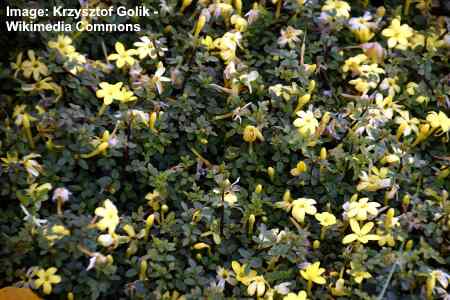
Dwarf jasmine (Jasminum parkeri) is a good plant to cultivate in a tiny garden or pots since it is little in size and has yellow blooms. Dwarf jasmine is a tiny evergreen shrub that grows to be just 1 foot (30 cm) tall and has a spreading growth. One of the most distinguishing features of dwarf jasmine is its bright yellow flowers, in addition to its small size. Five yellow lobes or petals make up these exquisite flowers.
From spring through the fall, you may anticipate to see a lot of these yellow jasmine blooms. The size of the leaves is one distinguishing feature between dwarf jasmine and other jasmine types. The dwarf jasmine plant has compact foliage with short stems. Dwarf jasmine isn’t as fragrant as other types, but it does emit fragrances of jasmine.
Plant dwarf jasmine in pots or use it as a colorful groundcover plant. The jasmine shrub may also be shaped into various designs. For its delicate foliage and sun-yellow blooms, dwarf jasmine is also grown for cut flower displays. Zones 7-10 are ideal for this plant.
Wild Jasmine (Jasminum parkeri, Jasminum angustifolium)

Common yellow jasmine (Jasminum fruticans) is a tiny shrub with fragrant yellow flowers and small glossy leaves. It is also known as wild jasmine. Wild jasmine grows into a dome shape that is approximately 6.5 feet (2 meters) tall and does not trail. It has tubular yellow blooms that resemble a little trumpet. In the mid-summer through late-fall, you may expect to see common yellow jasmine.
Yellow wild jasmine has tiny oval glossy leaves that grow abundantly on the stems, as opposed to common jasmine. Wild jasmine is a cold-hardy strain of jasmine, which has one of the benefits. In colder environments and in certain areas, this evergreen plant can tolerate being a semi-evergreen plant. You may teach the plant to grow into a lovely hedge or let it provide excellent ground cover.
Jasminum angustifolium is another plant that is known as wild jasmine. The large clusters of white flowers and beautiful glossy leaves on this blooming climbing plant are spectacular. Zones 6b through 10 are ideal for this plant.
Pink Jasmine (Jasminum polyanthum)
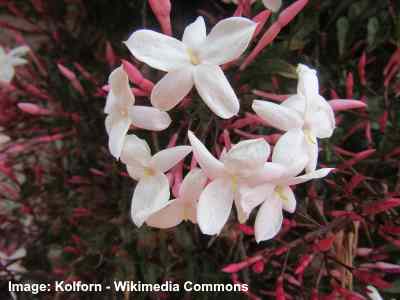
Pink jasmine is a climbing vine with fragrant white blooms and pink buds that is sometimes used as a decorative vine. The profusion of pink buds that embellish this shrubby vine gives the name pink jasmine. This kind of jasmine has an exotic, oriental look with its 5-petal white blossoms and pinkish buds.
From early spring until late fall, pink jasmine has a strong fragrance. Theendum of light pink tubes holds the lovely white blossoms. These flowers, like common jasmine, grow in huge clusters and are 1″ (2.5 cm) broad. Pink jasmine’s strong fragrance is one of its characteristics. The intensity of the scent produced by this climbing vine is complemented by the large number of flowers.
Pink jasmine is one of the biggest of the jasmine cultivars available. This fast-expanding vine may grow to be 20 feet (6 meters) tall. As a result, it makes an ideal aromatic flowery ground cover for gardens or to embellish arches and trellises. In the winter and early spring, you may expect pink jasmine to bloom. Pink jasmine blossoms may be seen all year in warm regions if you live there long enough. Zones 9 through 10 are ideal growing conditions.
Italian Jasmine (Jasminum humile)
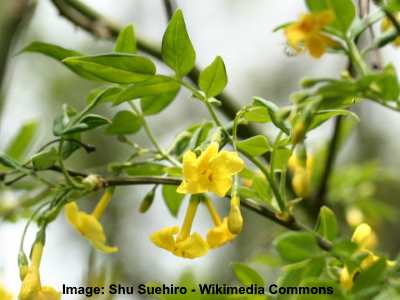
Jasminum humile (Italian jasmine) is a yellow jasmine that grows in Asia. The Italian jasmine, which may grow to be between 8 and 13 feet (2.5 and 4 meters), is a semi-evergreen shrub. Rather of trailing vines, the woody stems develop more like a shrub. The form of the lovely brilliant yellow tubular blooms of Italian jasmine is an unique characteristic. Each has five fan-shaped petals that spread out at the end of a tube-like bloom. These tubular blooms emerge in tiny clusters and hang down like little bells, and they contrast wonderfully with the dark green thick leaves.
Single flowers and dazzling double flowers may be seen on Italian jasmine. In the spring and summer, you can expect an profusion of flowers to brighten up your garden, as well as voluminous jasmine scents. Due to its ease of cultivation even in chilly environments, Italian jasmine is popular.
Even in harsh winters, this cold-hardy sort of jasmine may keep its leaves. Beautiful yellow fragrant blooms in early spring until the end of summer will reward you after the frost has passed. In zones 7 through 11, it thrives. In very cold winters, they may need additional protection.
Primrose (Japanese) Jasmine (Jasminum mesnyi)
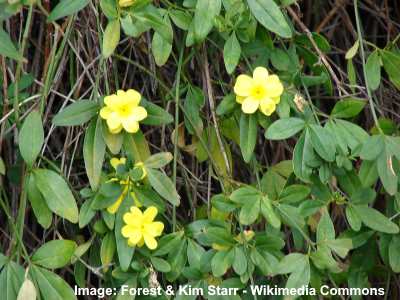
Another kind of jasmine with yellow flowers is Primrose jasmine (Jasminum mesnyi), which has bigger blossoms than other kinds. The blooms on Primrose jasmine are substantially bigger than those of other jasmine varieties. In warm regions, primrose jasmine is known as Japanese jasmine and is a scrambling form of jasmine vine. It’s frost sensitive and can’t handle it. The climber has a spread of 3 to 7 feet (1 to 2) and can reach heights of 10 feet (3 meters). You’ll need to trim Primrose jasmine regularly to keep it looking good because it’s a vigorous climber. Zones 8–11 are ideal for it.
Arabian Jasmine (Jasminum sambac)

Jasmine tea is frequently flavored with the fragrance of Arabian jasmine flowers (Jasminum sambac). Any garden may be enhanced by the fragrant star-shaped white blooms and glossy leaves. In warm areas, Arabian jasmine is a spreading form of evergreen Jasmine that thrives. The vines have large glossy leaves, which contrast with the clean white blooms. Each cluster may contain three to twelve flowers. Each blossom has a strong fragrance and is about 1 inch (2.5 cm) broad.
The flowers transition from brilliant white to light pink as they develop. For a climber, Arabian jasmine grows to a modest height. The vine will grow to be between 6 and 10 feet (1.8 and 3 meters) tall. In the summer, you can also cultivate the trailing vines as groundcover, producing a blanket of snow-white flowers. It thrives in the 9-12 zone range.
Arabian Jasmine ‘Grand Duke of Tuscany’
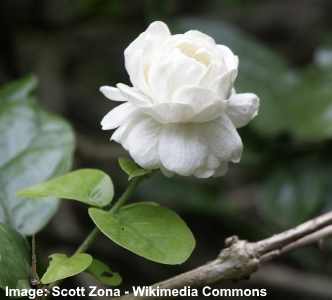
One of the most gorgeous and elegant types of jasmine blossoms is the Arabian Jasmine cultivar known as the Grand Duke of Tuscany. This is a fragrant and attractive Arabian jasmine (Jasminum sambac) cultivar. The huge white double bloom blooms of the Grand Duke of Tuscany are the most prominent feature. Rather than the typical jasmine blooms, these jasmine blooms resemble roses. The ruffled petals give the fragrant blossoms a bushy appearance. This Arabian jasmine plant’s stunning look is further enhanced by its deep green ruffled leaves.
The Arabian Jasmine ‘Grand Duke of Tuscany’ is a slower grower than other white jasmine species. It may reach a height of up to 3 feet (90 cm). This bushy shrub may bloom all year depending on your climate. The blooming season, however, is in the summer in colder areas. In zones 9 through 12, it thrives.
Winter Jasmine (Jasminum nudiflorum)
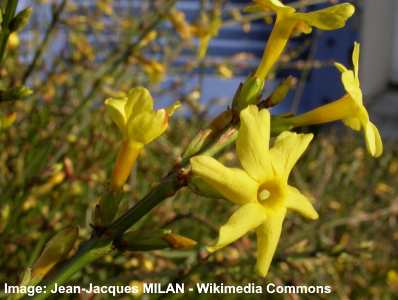
Winter jasmine has beautiful, fragrant blooms that give it a brilliant hue throughout the winter. The winter jasmine (Jasminum nudiflorum) is a deciduous plant that grows to about 3 feet tall. This jasmine blooming bush will brighten up your yard with brilliant yellow bushes if the weather permits.
Winter jasmine may be cultivated as a shrub or vine. Winter jasmine grows as a shrub and can reach heights of 4 feet (1.2 meters) when it is mature. The creeping stalks can grow up to 15 feet (4.5 meters) when grown as a vine. Its thin green stems, dark green leaves, and lemon-yellow blooms make it ideal for cascading down walls, up trellises, or around arbors. Zones 6 through 9 are ideal for growing it.
Indian Jasmine (Jasminum multiflorum)

Indian jasmine (Jasminum multiflorum) is a lovely kind of jasmine plant with snow-white blossoms that lack fragrance. Other names for Indian jasmine include ‘Winter jasmine,’ ‘Downy jasmine,’ and ‘Star jasmine.’ Each flower has eight spreading petals that radiate from the center.
Indian jasmine blooms have no distinct fragrance, unlike many other jasmine species. Yet, its fragrance is overshadowed by its loveliness throughout the flowering season from November to February. The Indian jasmine, which may grow up to 10 feet (3 meters) in height, is a fast-growing climbing plant. Zones 8a through 11b are ideal for this plant.
Stiff Jasmine (Jasminum volubile)

Aussie Wax Jasmine or Wax Jasmine is another name for Jasminum volubile, which is a native of Australia. It has huge egg-shaped glossy leaves and can get lengths of 15 to 30 feet (4.5 to 9 meters) through its twining vines. Stiff jasmine has tiny star-shaped white blossoms that resemble a pinwheel, much like Angel Wing jasmine. Zones 8b through 11 are ideal for this plant.
Florida Jasmine (Jasminum floridum)
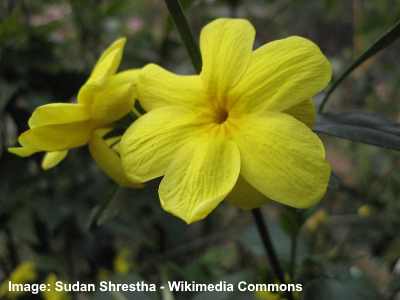
Jasminum floridum var. floridum The Florida jasmine (Jasminum floridum) is a species of jasmine native to China that has beautiful yellow blooms. This low-maintenance jasmine shrub, which grows to be 3′ – 5′ (0.9 – 1.5 m) tall and broad, is a kind of semi-evergreen to evergreen shrub that thrives in dry conditions. It has small yellow flowers and dark green foliage. Zones 6a through 10b are suitable for this plant.
Are Jasmine Plants Toxic?
According to the ASPCA, true jasmine plants from the Oleaceae family are nontoxic to humans, dogs, cats, and horses. False jasmine, on the other hand, is a poisonous plant that may be found in a variety of locations. False jasmine plants are not members of the Oleaceae family, despite having the word “Jasmine” in their name. Toxic chemicals that are harmful to people and animals may be found in Carolina jasmine and yellow jasmine.
